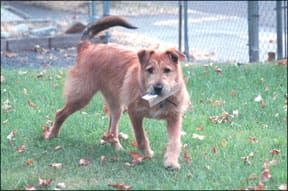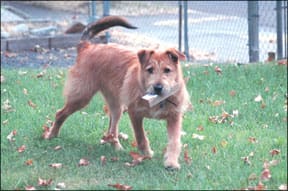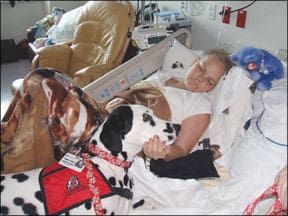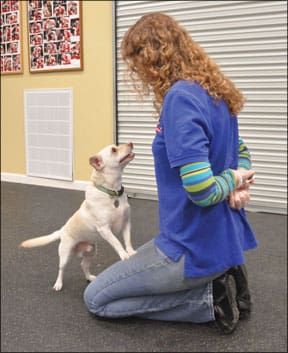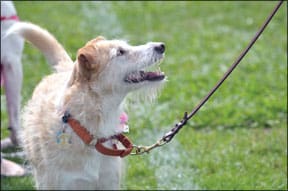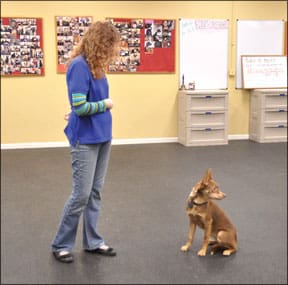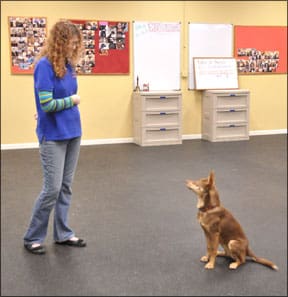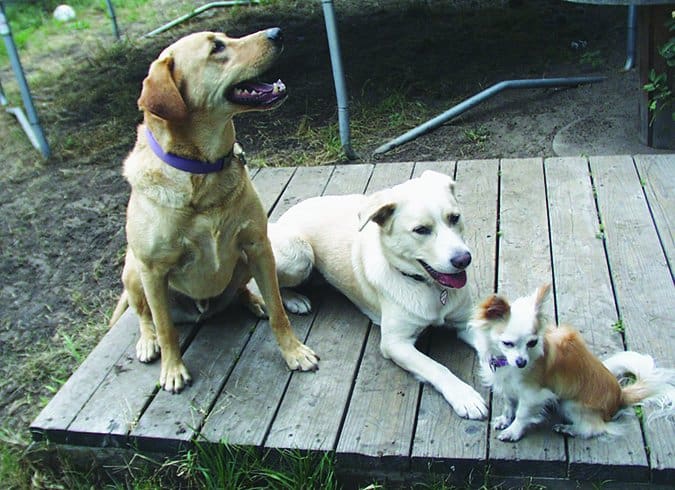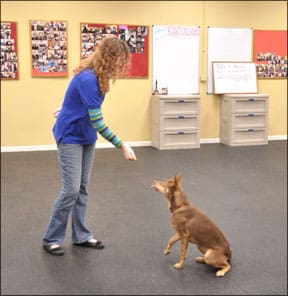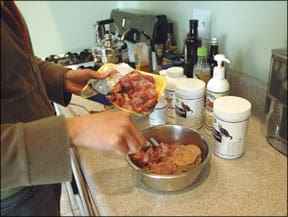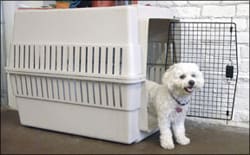[Updated March 6, 2018]
Denise Mankin, DVM, was on duty late one night in a Des Moines, Iowa, emergency veterinary clinic when Yeller, a Labrador Retriever, was rushed in sporting a fresh wound to his back. Yeller had been shot after escaping from his rural home.
Photo courtesy Hemopet.
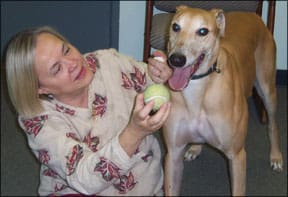
After stabilizing Yeller with IV fluids, antibiotics, and pain medications, Mankin opened up the dog’s abdomen to find blood filling his abdominal cavity. A bullet had perforated Yeller’s small intestine in five different locations, and two of the sites were hemorrhaging profusely. Within moments, his blood pressure plummeted. As Mankin worked desperately to tie off the blood supply to his damaged bowel, Yeller went into cardiac arrest. Cardiac drugs restored Yeller’s heart beat, and donor blood, having been warmed for transfusion, was pumped into him.
If your dog were to require an emergency blood transfusion, would your veterinarian have access to blood to save your dog’s life?
Veterinary medicine has become increasingly sophisticated, with trends paralleling those in human medicine – including the increased demand for canine blood and therefore formal blood banking services. Well-equipped private emergency clinics often maintain their own blood banks. Smaller clinics may rely on local blood donor programs or banking services might be provided by university veterinary teaching hospitals. A few commercial and non-profit animal blood banks also have been established.
However, according to world-renowned veterinarian W. Jean Dodds, CEO and founder of Hemopet in Garden Grove, California, “Despite these efforts, most of the country’s needs are not being met. The demand exceeds supply and the individual clinic programs may not be standardized to ensure safety and efficacy. A coordinated national effort is still an essential next step to maximally utilize what is available and set appropriate procedural standards.”
The University of Georgia’s College of Veterinary Medicine in Athens is one of many vet schools that has a canine (and feline) blood donor program. Its program utilizes thoroughly screened donor dogs belonging to veterinary school staff, students, and faculty. Producing close to 400 units of product per year, the UGA blood bank serves only critical care patients who are treated at the university’s small animal hospital; it does not provide blood to outside veterinary clinics. Despite this volume, the UGA blood bank can’t completely meet the demand from the university’s veterinary hospital – blood products expire, sometimes demand is too high – so it, too, will occasionally order from a national canine blood bank.
There are advantages and disadvantages of obtaining blood or blood products from a local donor and blood banks. According to Dr. Dodds, “As long as the local donor is blood type compatible and screened for infectious diseases, this blood – if properly collected and prepared – is just as beneficial as blood obtained from the handful of commercial veterinary blood banks in the country, large veterinary emergency clinics and institutions such as the Animal Medical Center in New York, or veterinary school blood donor programs that serve their clinical teaching hospitals.

“The advantage of the products from an animal blood bank are proven quality, prepared according to generally acceptable veterinary transfusion medicine standards or regulations (California only), and availability. Blood from these blood banks can be stored refrigerated for up to 46 days (packed red blood cells) and frozen for up to 5 years (fresh-frozen plasma).”
Blood Products and Their Uses
There are a number of acute and chronic conditions that call for your dog to be treated with blood or blood products. “Acute conditions include trauma, surgery, acute hemolytic anemia, or bleeding from accidents such as rat poisoning or from an inherited bleeding disease,” says Dr. Dodds.
“Chronic conditions include chronic disease, cancer, chemotherapy reactions, immune-mediated blood cell destruction, recurrent bleeding from an inherited condition, liver failure, bone marrow failure, or kidney failure.”
Blood transfusions don’t come cheap. At UGA, some canine blood components cost $150 to $300 per unit, and up to $500 for whole blood. A dog suffering from an acute crisis can require $1,000 worth of blood products, alone, in one day.
The most commonly used blood components are whole blood, packed red blood cells, fresh and frozen plasma, and cryoprecipitate. One of Dr. Dodds’ missions is to educate the veterinary community about efficiently and safely utilizing this precious resource, including using blood components, rather than whole blood, for transfusions.
Whole blood is collected directly from a donor animal. It can be used immediately or chilled for future transfusion or separation into blood components. Whole blood contains red blood cells, coagulation factors, and some white cells and platelets – but only when used within 24 hours of collection. Whole blood is generally reserved for use in acute cases in which the patient has lost a great volume of blood.
Packed red blood cells (PRBCs) are a concentrated source of red blood cells. This is the preferred source of red blood cells for most medical needs; PRCBs have a longer shelf life than whole blood, avoid the risk of “fluid volume overload” in compromised patients, and pose less risk of adverse immunologic reactions to plasma proteins.
Fresh plasma is essentially blood from which the red blood cells have been removed; it’s sometimes referred to as “platelet-poor plasma.” Fresh frozen plasma is the same thing, only frozen. Platelet-rich plasma is just what it sounds like; platelets (also known as thrombocytes) play a critical role in blood clotting. If a dog has too few platelets, excessive bleeding may occur. Platelet-rich plasma may be given to dogs with platelet dysfunction, or to sustain oncology patients whose platelets have been damaged by chemotherapy. Cryoprecipitate is a plasma concentrate indicated for treatment of severe bleeding (or in anticipation of surgically caused bleeding) caused by deficiences of plasma factor VIII, von Willebrand factor, or fibrinogen.
Your Dog’s Blood Type
Most of us are familiar with the concept of blood “type” – the phrase is going by the way in favor of the phrase blood “group.” In dogs, there are at least 12 different canine blood groups; 6 are fairly common. Blood groups are determined by the presence or absence of different antigens on the surface of the dog’s red blood cells; these are known as Dog Erythrocyte Antigens (DEA) and are identified by numbers, such as 1.1, 1.2, 3, and 4. To make matters even more confusing, a dog can have more than one group; for example, he can be “typed” as DEA 4 and 7, or DEA 1.1, 4, and 7!
As with humans, there is a “universal donor” blood group for dogs: DEA 4. If the emergency is not life-threatening, commercial animal blood products such as packed red blood cells and fresh-frozen plasma can be ordered by your veterinarian for overnight delivery anywhere in North America. These blood products typically come from so-called “universal donor” dogs; true universal donor blood is automatically compatible with the red blood cell type of any recipient dog patient.
Also like humans, dogs can suffer adverse reactions to transfused blood or blood products from dogs with types that are different from their own. Transfusion reactions rarely occur upon the first transfusion – but a transfusion from a dog with a different blood type than the recipient will sensitize the recipient’s immune system to that type. Subsequent transfusions with the same type of blood in the future will cause an adverse transfusion reaction. This is why blood typing for “repeat customers” is very important.
Vet emergency clinics generally keep in-office blood typing equipment on hand, so they can type your dog’s blood before giving him an emergency transfusion, but these kits are less reliable than tests conducted by veterinary laboratories. Having your dog’s blood sent to a lab for typing is highly recommended by many veterinary experts. It’s inexpensive and easy, and having the information ahead of time could be incredibly helpful if your dog had a serious medical emergency or trauma.
“It is always medically sound to know the blood type of the donor blood, and if not from a universal donor, the blood type of the recipient patient should also be known,” says Dr. Dodds. “Even if an emergency transfusion was given between two dogs of unknown type, the donor and recipient can always be blood typed after the fact for future reference.”
“Crossmatching” is another laboratory tool that can determine serologic compatibility (or incompatibility) between a donor and recipient. In a crossmatch, donor red cells are mixed with plasma from the recipient. If antibodies exist in the recipient plasma to antigens on the red cells of the donor, transfusion reactions can occur. Previously transfused dogs should be crossmatched prior to subsequent transfusions, even if the transfusion is from the previous donor.
Donor Dogs — Do You Have What It Takes?
Commercial animal blood banks in California are closed colonies of dogs (or cats) and are regulated by law through the State Department of Food & Agriculture. These blood banks are licensed and inspected annually by the state.
In the state of California, commercial sale of volunteer donor blood from privately owned pets is not permitted.
W. Jean Dodds, DVM, established the first private 501(c)(3) non-profit animal blood bank, Hemopet, in July l99l. Dr. Dodds’ goal was to do for animals what the American Red Cross did for humans: develop a national blood bank and education network. Today, Hemopet services more than 2,000 veterinary clinics in the U.S., Canada and Hong Kong.
Hemopet’s licensed facility houses a colony of healthy, canine donors – all Greyhounds rescued from the racing industry – of universal blood type (DEA 4). Commercial animal blood banks in California are regulated by law through the State Department of Food & Agriculture. Hemopet’s Greyhounds are maintained in an outstanding environment, screened for an inclusive list of pathogens, current on all vaccinations, and neutered. They also have access to on-site 24 hour-a-day veterinary care. About 200 donors live in Hemopet’s new, large facility, and are part of a novel rescue-donor-adoption program, Pet Life-Line.
You should ask your veterinarian or call your local veterinary emergency hospital to see if they have a volunteer donor program. Your dog could be a volunteer blood donor if he or she is at least 50 pounds, of stable temperament, a young healthy adult, and, if female, preferably spayed (to avoid heat cycle influences). To qualify as a donor, a complete health exam is performed along with lab testing for CBC, serum chemistry, bleeding disease screening (e.g., for Von Willebrand disease), heartworm check, and screening for more common infectious diseases transmitted by blood.
Registered veterinary technician Anna Santos has been with the University of Georgia College of Veterinary Medicine, Small Animal Veterinary Teaching Hospital in Athens for 13 years. She cares for thousands of critical care patients yearly at the hospital, and heads its donor and transfusion program. She explains that canine blood donation is not a big deal for the dog — although the right temperament helps! The time from when a needle is placed (to draw blood) until it is removed is only about eight minutes. Santos describes it as very similar to the experience of donating blood at the Red Cross, all the way down to the “cookies” provided to patients post-donation! Each appointment takes less than a half hour, but the donor dog’s caregiver must be willing to make a significant commitment to the program: UGA requires that the dog come in every two months to donate over a period of one year. This is not an uncommon requirement made by canine blood banks.
The Gift of Life
After two hours in surgery, and an additional four hours on a ventilator, Yeller (the Labrador who’d been shot) made a full recovery. The combination of expert veterinary care and donor blood saved his life. Dr. Mankin says she has never lost a patient due to lack of blood availability; her clinic has always had blood on hand or had a donor dog nearby for blood collection if their stock was depleted. How many lives has she helped save with donor blood? “Wow, there are soooo many stories!”
CANINE BLOOD TRANSFUSIONS: OVERVIEW
1. Talk with your vet about having your dog’s blood typed. Keep a permanent record of the results in a safe place.
2. Find out in advance if blood would be readily available — and from where — for your dog should she require an emergency transfusion.
3. If your dog is young and healthy, consider signing her up to be a blood donor. Understand that she will be thoroughly screened for temperament and health, and that you’ll be signing up for a significant, but worthwhile, commitment. Your dog might save another’s life!
Lisa Rodier is a frequent contributor to WDJ. She lives in Alpharetta, GA, with her husband and a senior Bouvier.





